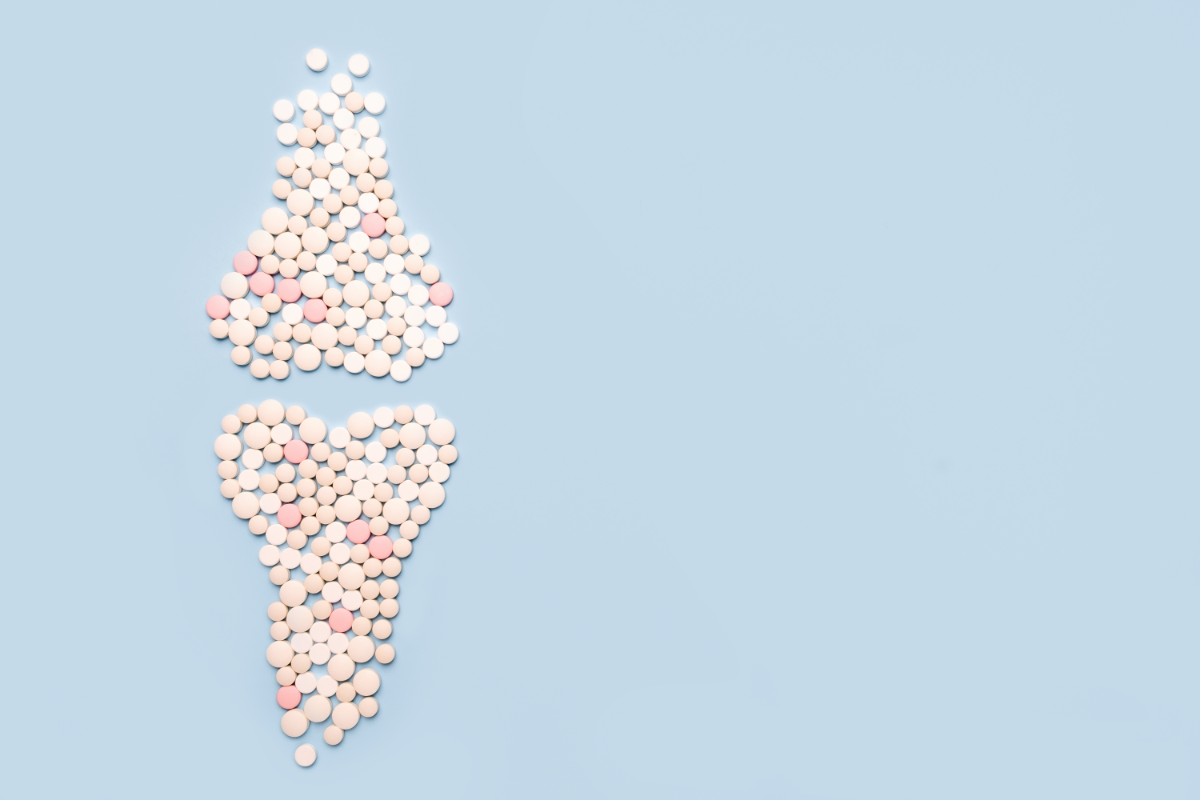Osteology is the part of medicine that deals with bone pathologies; it is the study of bones. Osteoporosis, for example, is a pathology of the musculoskeletal system; it is a bone disorder.
Bones play an important role in :
- The structure of the body
- Soft tissue support and visceral protection
- Movement and posture
- Development of blood cells (haematopoiesis) in the red bone marrow of flat bones
Bones are made up of 70% mineral salts, which give them rigidity and firmness, and organic matter including adipose tissue, proteins and cellular biochemical components. It is therefore important to maintain a constant level of calcium in the blood. In fact, when the destruction of bone tissue exceeds its synthesis, bone density decreases. The cells of interest are osteoblasts (young bone cells that play a role in bone structure), which are attacked by osteoclasts (destructive cells that lead to bone resorption and destruction in order to recover mineral salts). The resulting pathology is osteopenia or osteoporosis.
A naturopathic approach to osteoporosis can offer alternative or complementary ways of managing and preventing the progression of this condition.
What is osteoporosis?
Osteoporosis, often recognised as a silent disease, raises many questions. By deciphering its subtleties, we can better understand its manifestations and implications. Here’s a more detailed look at this metabolic disease affecting bone structure.
Osteoporosis is a metabolic disease that affects the structure of bone tissue, with a reduction in bone mass due to the normal ageing process.
It is important to understand that there are different forms of osteoporosis, each with its own specific characteristics. These variations are as follows:
Primary osteoporosis :
Constituting the majority of cases, around 95%, primary osteoporosis is itself subdivided into two distinct types:
Type I primary osteoporosis :
Primarily targeting women aged 51 to 75, this type of osteoporosis is closely linked to post-menopausal hormonal changes. The reduction in oestrogen during this period increases the function of osteoclasts, the cells responsible for breaking down bone tissue.
Type II primary osteoporosis :
Also known as “senile osteoporosis”, it affects both men and women from the age of 70. This form of osteoporosis is a natural consequence of ageing.
Understanding the different manifestations of osteoporosis is crucial to its proper management. Whether it is post-menopausal or senile osteoporosis, it is essential to be informed and to take preventive measures to maintain optimal bone health. An in-depth knowledge of the nuances of this disease is a valuable asset for anyone wishing to preserve their well-being.
Secondary osteoporosis :
Secondary osteoporosis accounts for 5% of cases, and is caused by certain conditions such as chronic renal failure, hyperthyroidism, hypogonadism or the use of drugs such as corticoids, barbiturates and heparins. Alcohol and tobacco accelerate bone loss (kyphosis, kyphoscoliosis).
The main causes are varied. They can be due to age and ageing, the female sex, excessive consumption of tobacco and alcohol. But it can also be due to a lack of physical activity, a vitamin D and/or calcium deficiency, a genetic predisposition, the menopause (particularly early menopause), corticosteroid therapy lasting more than 3 months, or certain endocrine pathologies (hyperparathyroidism, hyperthyroidism).
Some naturopathic advice for diagnosed osteoporosis
Osteoporosis is a metabolic bone disorder that requires special attention, particularly in terms of nutrition and lifestyle. Naturopathy, which focuses on natural interventions, offers strategies to support those suffering from this disease. Here is a series of naturopathic recommendations for optimising bone health:
Ensure adequate calcium intake
Calcium is the main mineral making up our bones and teeth. Adequate intake from an early age can prevent bone loss later in life. Although dairy products are a common source of calcium, other foods such as green leafy vegetables and nuts can also help meet your daily needs.
Incorporate silicon into your diet
Silicon plays a crucial role in the formation and maintenance of bone collagen. It is a trace element that is often overlooked, but its presence is essential for strengthening bone density. Sources of silicon include wholemeal cereals, bananas and green beans.
Importance of vitamin D
Vitamin D is essential for the absorption of calcium from the intestine and helps maintain calcium and phosphate levels for bone mineralisation. Vitamin D can be synthesised by the skin during exposure to the sun or obtained from foods such as cod liver oil (250.00 µg), smoked herring (22.00 µg), and other sources mentioned below:
- Butter
- Mushrooms
- Cereals
- Pilchard in tomato sauce (tinned) 14.00 µg
- Dehydrated vegetable stock 13.80 µg
- Fried mackerel 12.30 µg
- Grilled sardines 12.30 µg
- Raw farmed Nile tilapia 12.20 µg
- Anchovy, raw 11.00 µg
- Baked farmed rainbow trout 11.00 µg
- Sardines in olive oil 10.80 µg
Prioritise physical activity
Physical exercise, particularly lifting weights and weight training, stimulates bone formation and improves bone density. Activities such as walking, dancing or climbing stairs can help strengthen bones and prevent bone loss. It is advisable to do at least 30 minutes of moderate physical activity most days of the week.
Adopt a holistic approach to toxins
Smoking and alcohol consumption have been linked to reduced bone density. It is therefore essential to reduce consumption or abstain completely in order to optimise bone health. The harmful effects of tobacco and alcohol on bone can be exacerbated with age.
Be careful with diets
Very restrictive diets can deprive the body of essential nutrients needed for bone health. Dairy products, for example, are a rich source of calcium and vitamin D. If you choose to avoid dairy products, it’s crucial to find these nutrients elsewhere.
Combine calcium with vitamin D3
Vitamin D3, the most effective form of vitamin D, improves the body’s absorption of calcium. Taking these two nutrients together can maximise their beneficial effects on bone density.
Caution with certain drinks when taking medication
Alendronate is frequently prescribed to treat osteoporosis. However, the caffeine present in tea and coffee can interfere with the absorption of this medicine. It is therefore advisable to avoid these beverages or to consume them several hours apart from the medication.
Dietary recommendations of the French Society of Rheumatology and the GRIO:
| Recommended foods | Benefits | Foods to avoid | Reasons |
|---|---|---|---|
| Mediterranean diet | Rich in antioxidants, vitamins, polyphenols and omega-3 fatty acids. Promotes bone density. | Unbalanced diets (Western) | Can compromise the necessary nutritional balance. |
| Dairy products (2-3 times a day) | Provide calcium and high-quality protein. | Vegan diets (without substitutions) | Lack essential nutrients such as calcium and protein. |
| Fish (at least 2 times a week) | Source of protein and potentially omega-3 fatty acids. | Weight-loss diets (without excess weight) | Risk of reducing the intake of necessary nutrients. |
| Fruit, Vegetables, Pulses, Cereals | Provide vitamins, minerals and fibre. | Excessive alcohol consumption | Harmful to bone health. |
| Olive oil | Source of good fats and antioxidants. | Daily consumption of soft drinks | Can adversely affect bone density. |
Which plants should I take for osteoporosis?
Horsetail (EPS):
This plant, which is naturally composed of silicon and potassium, has remineralising properties that can be used in the consolidation of fractures, bone fragility, post-menopausal osteoporosis, cramps and spasmophilia.
Bamboo (TM):
Over 92%rich in silica, bamboo is a remineralising agent indicated for osteoporosis.
Scots Pine (bud):
The Scots Pine bud has a regenerative action on hard tissue (bone and cartilage). It is generally indicated for osteoarthritis and osteoporosis.
Mountain Pine (bud TM):
-
- Pinus montana and Rosa canina are especially active in post-menopausal osteoporosis
- Pinus montana and Rubus fruticosus are active in senile osteoporosis and osteoarthritis in general
Alfalfa (EPS):
Alfalfa is essentially naturally loaded with mineral salts and silicon, and is a remineralising plant.
Osteoporosis is a silent skeletal disease that affects a huge number of people (mostly women). A special day (20 October) has been set aside to raise awareness of the risks and to help people adopt a healthy lifestyle.
References
- https://health.clevelandclinic.org/vitamin-k2
- https://www.ncbi.nlm.nih.gov/pmc/articles/PMC9524880/
- https://www.ncbi.nlm.nih.gov/pmc/articles/PMC6480005/
- https://has-sante.fr/upload/docs/application/pdf/2019-05/bum_osteoporose_maj_avril2019.pdf
- https://www.grio.org/





